
Louise Nevelson was an American sculptor known for her monumental, monochromatic, wooden wall pieces and outdoor sculptures. Born in the Poltava Governorate of the Russian Empire, she emigrated with her family to the United States in the early 20th century. Nevelson learned English at school, as she spoke Yiddish at home.
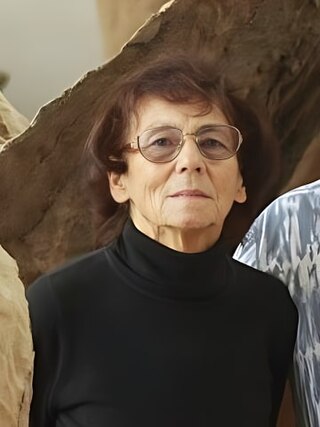
Magdalena Abakanowicz was a Polish sculptor and fiber artist. Known for her use of textiles as a sculptural medium and for outdoor installations, Abakanowicz has been considered among the most influential Polish artists of the postwar era. She worked as a professor of studio art at the University of Fine Arts in Poznań, Poland, from 1965 to 1990, and as a visiting professor at University of California, Los Angeles in 1984.
Martin L. Puryear is an Afro-American artist known for his devotion to traditional craft. Working in a variety of media, but primarily wood, his reductive technique and meditative approach challenge the physical and poetic boundaries of his materials. The artist's Liberty/Libertà exhibition represented the United States at the 2019 Venice Biennale.
Alice Aycock is an American sculptor and installation artist. She was an early artist in the land art movement in the 1970s, and has created many large-scale metal sculptures around the world. Aycock's drawings and sculptures of architectural and mechanical fantasies combine logic, imagination, magical thinking and science.
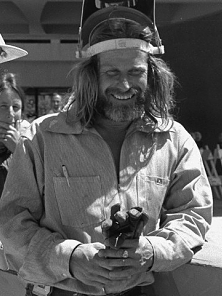
Marco Polo di Suvero, better known as Mark di Suvero, is an abstract expressionist sculptor and 2010 National Medal of Arts recipient.

The University of Michigan Museum of Art (UMMA) is one of the largest university art museums in the United States, located in Ann Arbor, Michigan with 94,000 sq ft (8,700 m2). Built as a war memorial in 1909 for the university's fallen alumni from the Civil War, Alumni Memorial Hall originally housed University of Michigan's Alumni office along with the university's growing art collection. Its first director was Jean Paul Slusser, who served from 1946 to his retirement in 1957.

The Olympic Sculpture Park, created and operated by the Seattle Art Museum (SAM), is a public park with modern and contemporary sculpture in downtown Seattle, Washington, United States. The park, which opened January 20, 2007, consists of a 9-acre (36,000 m2) outdoor sculpture museum, an indoor pavilion, and a beach on Puget Sound. It is situated in Belltown at the northern end of the Central Waterfront and the southern end of Myrtle Edwards Park.

The National Gallery of Art Sculpture Garden is the most recent addition to the National Gallery of Art in Washington, D.C. in the United States. It is located in the National Mall between the National Gallery's West Building and the Smithsonian Institution's National Museum of Natural History.
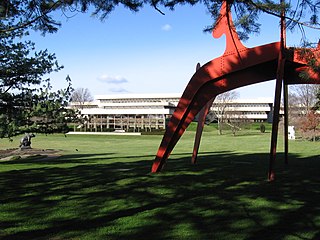
The Donald M. Kendall Sculpture Gardens is a collection of 45 pieces of outdoor sculpture at the PepsiCo world headquarters in Purchase, New York. The collection includes work from major modern sculptors including Auguste Rodin, Henry Moore, Alexander Calder, and Alberto Giacometti.
Charles Albert Ginnever, also known as Chuck Ginnever, was an American sculptor, known primarily for large-scale abstract steel sculptures that defy simple understanding, as the works seem to constantly change form as one moves around them in time and space.

Snowplow is an abstract outdoor sculpture by American artist Mark di Suvero located on the grounds of the Indianapolis Museum of Art. The sculpture was purchased in 1975 by the Indianapolis Sesquicentennial Commission and first installed in Indianapolis, Indiana in 1977.
The International Sculpture Center is a 501(c)3 nonprofit organization founded in 1960 by Elden Tefft and James A. Sterritt at the University of Kansas. It is currently located at Grounds For Sculpture in Hamilton, New Jersey.
Landmarks is the public art program of The University of Texas at Austin. Its projects are exhibited throughout the university's 433-acre main campus.
Vancouver International Sculpture Biennale is an open-air museum for Contemporary Art in Canada. It is a non-profit charitable organization that mounts a major outdoor sculpture exhibition, biennially. Each exhibition is accessible for a two-year period, featuring international artists, New Media and Performance Art, in the cities of Vancouver, New Westminster, North Vancouver, Squamish and Richmond public spaces. The sculpture is in situ and is open to the public 24/7, 365 days a year.

Are Years What? is a sculpture by American artist Mark di Suvero. It is in the collection of the Hirshhorn Museum and Sculpture Garden, in Washington, D.C., United States. The sculpture is named after poet Marianne Moore's "What Are Years". From May 22, 2013 through May 26, 2014, the sculpture resided temporarily in San Francisco, as part of the San Francisco Museum of Modern Art's Mark di Suvero exhibition at Crissy Field.
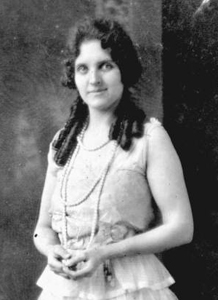
Dorothy Mayhall (1925–1995) was an American museum director and sculptor. She worked at art museums in New York and Connecticut, primarily exhibiting contemporary art.
Brooke Kamin Rapaport is Artistic Director and Martin Friedman Chief Curator at Madison Square Park Conservancy in New York City. She is responsible for the outdoor public sculpture program of commissioned work by contemporary artists. With an exhibition of Martin Puryear's work, Martin Puryear: Liberty/Libertà, Rapaport served as Commissioner and Curator of the United States Pavilion at the 2019 Venice Biennale. She frequently speaks on and moderates programs on contemporary art and issues in public art. Rapaport also writes for Sculpture magazine where she is a contributing editor. She lives in New York City.
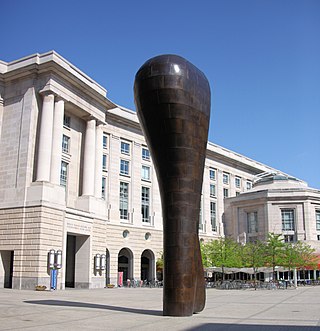
Bearing Witness is an outdoor 1997 sculpture by Martin Puryear, installed outside the Ronald Reagan Building and International Trade Center in Washington, D.C., in the United States. Twenty plus years after its construction the sculpture follows the characteristic style of Puryear and remains standing with minimal maintenance twenty plus years after its construction. The meaning of the sculpture is left up to interpretation, although many observers read into the inspirations Puryear may have had when designing the work.

The Western Washington University Outdoor Sculpture Collection is a public sculpture collection founded in 1960. The collection contains thirty-six public sculptures spanning 190 acres of the Western Washington University campus.

Shang is a public art work by artist Mark di Suvero located at the University of Michigan Museum of Art (UMMA) in Ann Arbor, Michigan. The kinetic sculpture is an abstract form; it was installed on the sidewalk by the Maxine and Stuart Frankel and The Frankel Family Wing of the museum, at 525 South State Street. In October 2020, it was deinstalled since it was a long-term loan that had been bought by a private collector.
















